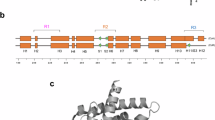Play all audios:

ABSTRACT This study addresses the contributions of specific retinoid receptors during all-_TRANS_-retinoic acid (RA)-mediated differentiation and growth suppression of human embryonal
carcinoma cells. The pleiotropic effects of RA are mediated by retinoic acid receptors (RARs) and retinoid X receptors (RXRs), members of the nuclear receptor family of transcription
factors. After RA-treatment the multipotent human embryonal carcinoma cell line NTERA-2 clone D1 (NT2/D1) displays limited proliferative potential, reduced tumorigenicity, and morphologic
and immunophenotypic neuronal maturation. RARγ over-expression in NT2/D1 cells signals mesenchymal NT2/D1 terminal differentiation while RARα and RARβ do not and RARγ overcomes retinoid
resistance in an NT2/D1 clone (NT2/D1-R1) having deregulated RARγ expression. Since RARγ transfectants do not display neuronal maturation, this study sought to identify cooperating retinoid
receptors engaged in NT2/D1 differentiation. Through gain of function experiments, this report highlights RXRβ as playing an important role along with RARγ in signaling differentiation of
NT2/D1 cells. Stable over-expression of RXRβ, but not RXRα or RXRγ, was found to signal NT2/D1 growth suppression and to induce a non-neuronal morphology and immunophenotype. Notably,
co-transfection of RARγ and RXRβ resulted in marked growth suppression and for the first time, expression of typical neuronal markers of NT2/D1 differentiation. To clarify the role of RXRβ
and RARγ in this differentiation program, a modified transient fibroblast growth factor-4 (FGF4) promoter-enhancer reporter assay that reflects effective RA-mediated differentiation of
NT2/D1 cells was employed. Transfection of RARγ or RXRβ in NT2/D1 cells augments transcriptional repression of the FGF4 reporter and RARγ and RXRβ co-transfection markedly repressed reporter
activity, indicating the combined role of these receptors in RA-induced NT2/D1 differentiation. Taken together, these findings reveal specific retinoid receptors must cooperate to signal
terminal growth suppression and maturation of NT2/D1 cells. Since the transcriptional repression of FGF4 is coupled to the effective maturation of human embryonal carcinoma cells, the
described co-transfection strategy should prove useful to identify genes with positive or negative effects on the differentiation program of these tumor cells. Access through your
institution Buy or subscribe This is a preview of subscription content, access via your institution ACCESS OPTIONS Access through your institution Subscribe to this journal Receive 50 print
issues and online access $259.00 per year only $5.18 per issue Learn more Buy this article * Purchase on SpringerLink * Instant access to full article PDF Buy now Prices may be subject to
local taxes which are calculated during checkout ADDITIONAL ACCESS OPTIONS: * Log in * Learn about institutional subscriptions * Read our FAQs * Contact customer support SIMILAR CONTENT
BEING VIEWED BY OTHERS EFFECTS OF RARΑ LIGAND BINDING DOMAIN MUTATIONS ON BREAST FIBROEPITHELIAL TUMOR FUNCTION AND SIGNALING Article Open access 03 January 2025 RHOA/C INHIBITS
PROLIFERATION BY INDUCING THE SYNTHESIS OF GPRC5A Article Open access 27 July 2020 LINEAGE SPECIFIC TRANSCRIPTION FACTOR WAVES REPROGRAM NEUROBLASTOMA FROM SELF-RENEWAL TO DIFFERENTIATION
Article Open access 23 April 2024 AUTHOR INFORMATION Author notes * Begonia Mellado Present address: Servicio de Coordinacion Oncologica, Hospital Clinic, Barcelona, Spain * Kei-Siong Khoo
Present address: Department of Medical Oncology, Singapore General Hospital, Singapore AUTHORS AND AFFILIATIONS * Department of Medicine, Laboratory of Molecular Medicine, Memorial Hospital
and Molecular Pharmacology and Therapeutics Program, Sloan-Kettering Institute, Memorial Sloan-Kettering Cancer Center, New York, 10021, NY, USA Michael J Spinella, Sutisak Kitareewan,
Begonia Mellado, David Sekula, Kei-Siong Khoo & Ethan Dmitrovsky Authors * Michael J Spinella View author publications You can also search for this author inPubMed Google Scholar *
Sutisak Kitareewan View author publications You can also search for this author inPubMed Google Scholar * Begonia Mellado View author publications You can also search for this author
inPubMed Google Scholar * David Sekula View author publications You can also search for this author inPubMed Google Scholar * Kei-Siong Khoo View author publications You can also search for
this author inPubMed Google Scholar * Ethan Dmitrovsky View author publications You can also search for this author inPubMed Google Scholar RIGHTS AND PERMISSIONS Reprints and permissions
ABOUT THIS ARTICLE CITE THIS ARTICLE Spinella, M., Kitareewan, S., Mellado, B. _et al._ Specific retinoid receptors cooperate to signal growth suppression and maturation of human embryonal
carcinoma cells. _Oncogene_ 16, 3471–3480 (1998). https://doi.org/10.1038/sj.onc.1201876 Download citation * Received: 09 October 1997 * Revised: 28 January 1998 * Accepted: 28 January 1998
* Published: 14 July 1998 * Issue Date: 02 July 1998 * DOI: https://doi.org/10.1038/sj.onc.1201876 SHARE THIS ARTICLE Anyone you share the following link with will be able to read this
content: Get shareable link Sorry, a shareable link is not currently available for this article. Copy to clipboard Provided by the Springer Nature SharedIt content-sharing initiative
KEYWORDS * retinoic acid * differentiation * embryonal carcinoma * teratocarcinoma * retinoid receptors
